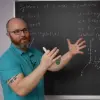

NARROW DISPLAY WARNING
You are most likely using a tablet or mobile device in portrait orientation. This website is best viewed using a typical computer screen with the browser window maximized.
Viewing this website in portrait orientation can cause problems with equations being longer than the screen width (you can scroll to the right), images being poorly sized, and the font size of maths text being much smaller than regular text. If your only option is a tablet or mobile device, your viewing experience will be better if you view this website in landscape orientation. You might need to refresh the page to fix any problems after rotating.
This method is useful for finding a second homogenous solution to a linear second order ODE when one homogeneous solution is known. This already happened for the $ay''+by'+cy = 0$ Repeated Real Root case. When the only known solution was $e^{rx}$ where $r$ was the repeated real root of the characteristic equation $ar^{2}+br+c = 0$, the second solution $xe^{rx}$ can be obtained using reduction of order.
Find the second homogeneous solution to the ODE when you are given only one homogeneous solution.
\begin{equation} y'' - 8y' + 16y = 0 \qquad y_{1}(x) = e^{4x} \end{equation} Do this by guessing the second homogeneous solution is of the form $y_{2}(x) = v(x)e^{4x}$ where $e^{4x}$ comes from the first homogeneous solution.Find the general solution to the ODE.
\begin{equation} x^{2}y'' - 3xy' + 3y = 0 \qquad y_{1}=x \end{equation}Find the general solution to the ODE.
\begin{equation} x^{2}\big(\ln|x|\big)^{2}y''-2x\ln|x|y'+\big(2+\ln|x|\big)y=0 \qquad y_{1}=\ln|x| \end{equation}Find the general solution to the ODE.
\begin{equation} (x-1)y''-xy'+y=0 \qquad y_{1}=e^{x} \end{equation}Reduction of order uses a guess $y_{2}(x) = v(x)y_{1}(x)$ which results in a new ODE for the function $v(x)$ with $v''(x)$ and $v'(x)$ terms, but no $v(x)$ term. There is no $v(x)$ term because the half of the product rule for the guess $v(x)y_{1}(x)$ that takes the derivative of $y_{1}(x)$ acts like the first homogeneous solution when plugged into the ODE.
\begin{equation} y''+p(x)y'+q(x)y=0 \qquad y_{2}(x)=v(x)y_{1}(x) \end{equation} \begin{equation} y_{2}''+p(x)y_{2}'+q(x)y_{2}=(vy_{1})''+p(x)(vy_{1})'+q(x)vy_{1}=0 \end{equation} \begin{equation} v''y_{1}+2v'y_{1}'+vy_{1}''+p(x)(v'y_{1}+vy_{1}')+q(x)vy_{1}=0 \end{equation} \begin{equation} y_{1}v''+\big(2y_{1}'+p(x)y_{1}\big)v'+\big(y_{1}''+p(x)y_{1}'+q(x)y_{1}\big)v=0 \end{equation} \begin{equation} y_{1}v''+\big(2y_{1}'+p(x)y_{1}\big)v'+0v=0 \end{equation} The $\big(y_{1}''+p(x)y_{1}'+q(x)y_{1}\big)v$ was replaced by $0v$ because $y_{1}$ is a homogeneous solution to the original ODE, and the original ODE is exactly what is in the parentheses, so all the $v(x)$ terms disappear. \begin{equation} y_{1}v''+\big(2y_{1}'+p(x)y_{1}\big)v'=0 \end{equation} Even though this is a second order ODE, we can use first order solution methods because there is no $v(x)$ term. To make it look like a first order ODE, we can replace $v'(x)=w(x)$ so it's not as confusing. \begin{equation} w(x) = v'(x) \qquad y_{1}w'+\big(2y_{1}'+p(x)y_{1}\big)w=0 \end{equation} Since $p(x)$ and $y_{1}(x)$ are known, we can solve for $w(x)$, which can be used to find $v(x)$, which can be used to find the $y_{2}(x)$ guess we started with.